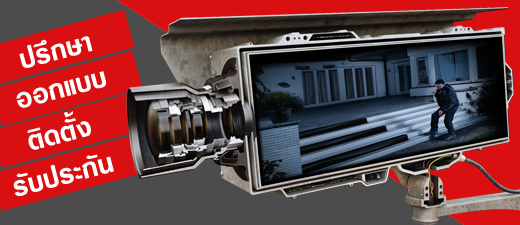หน้าแรก >> CCTV Surveillance
Video Technology Overview
2.1 OVERVIEW
The second half of the 1990s has witnessed a quantum jump in video security technology. This technology has manifest with a new generation of video components, i.e. digital cameras, multiplexers, DVRs, etc. A second significant activity has been the integration of security systems with computer-based LANs, wide area networks (WANs), wireless networks (WiFi), intranets and, Internet and the World Wide Web (WWW) communications systems.
World Wide Web (WWW) communications systems.
Although today’s video security system hardware is based
on new technology which takes advantage of the great
advances in microprocessor computing power, solid-state
and magnetic memory, digital processing, and wired and
wireless video signal transmission (analog, digital over the
Internet, etc.), the basic video system still requires the
lens, camera, transmission medium (wired cable, wireless),
monitor, recorder, etc. This chapter describes current video security system components and is an introduction to their operation.
The primary function of any video security or safety system is to provide remote eyes for the security force located at a central control console or remote site. The video system includes the illumination source, the scene to be viewed, the camera lens, the camera, and the means of transmission to the remote monitoring and recording equipment. Other equipment often necessary to complete the system include video switchers, multiplexers, VMDs, housings, scene combiners and splitters, and character generators.
This chapter describes the technology used to: (1) capture the visual image, (2) convert it to a video signal,
(3) transmit the signal to a receiver at a remote location,
(4) display the image on a video monitor, and (5) record
and print it for permanent record. Figure 2-1 shows the
simplest video application requiring only one video camera and monitor
The printer and video recorder are optional. The camera may be used to monitor employees, visitors, or people
entering or leaving a building. The camera could be
located in the lobby ceiling and pointed at the reception
area, the front door, or an internal access door. The monitor might be located hundreds or thousands of feet away,
in another building or another city or country with the
security personnel viewing that same lobby, front door, or
reception area. The video camera/monitor system effectively extends the eyes, reaching from observer location to
the observed location. The basic one-camera system shown
in Figure 2-1 includes the following hardware components.
• Lens. Light from the illumination source reflects off
the scene. The lens collects the light from the scene and forms an image of the scene on the light-sensitive
camera sensor.

• Camera. The camera sensor converts the visible scene
formed by the lens into an electrical signal suitable
for transmission to the remote monitor, recorder, and printer
• Transmission Link. The transmission media carries
the electrical video signal from the camera to the
remote monitor. Hard-wired media choices include:
(a) coaxial, (b) two-wire unshielded twisted-pair (UTP),
(c) fiber-optic cable, (d) LAN, (e) WAN, (f) intranet,
and (g) Internet network. Wireless choices include:
(a) radio frequency (RF), (b) microwave, or (c) optical
infrared (IR). Signals can be analog or digital.
• Monitor. The video monitor or computer screens display (CRT, LCD or plasma) the camera image by converting the electrical video signal back into a visible
image on the monitor screen.
• Recorder. The camera scene is permanently recorded
by a real-time or TL VCR onto a magnetic tape cassette
or by a DVR using a magnetic disk hard drive.
• Hard-copy Printer. The video printer produces a hardcopy paper printout of any live or recorded video image, using thermal, inkjet, laser, or other printing
technology.
The first four components are required to make a simple video system work. The recorder and/or printer is
required if a permanent record is required.
Figure 2-2 shows a block diagram of a multi-camera
analog video security system using these components plus
additional hardware and options to expand the capability
of the single-camera system to multiple cameras, monitors,
recorders, etc. providing a more complex video security
system.
Additional ancillary supporting equipment for more
complex systems includes: camera switchers, quads, multiplexers, environmental camera housings, camera pan/tilt
mechanisms, image combiners and splitters, and scene
annotators.
• Camera Switcher, Quad, Multiplexer. When a CCTV
security system has multiple cameras, an electronic
switcher, quad, or multiplexer is used to select different cameras automatically or manually to display the
images on a single or multiple monitors, as individual
or multiple scenes. The quad can digitally combine four cameras. The multiplexer can digitally combine 4, 9, 16,
and even 32 separate cameras.

• Housings. The many varieties of camera/lens housings
fall into three categories: indoor, outdoor and integral
camera/housing assemblies. Indoor housings protect
the camera and lens from tampering and are usually
constructed from lightweight materials. Outdoor housings protect the camera and lens from the environment:
from precipitation, extremes of heat and cold, dust, dirt,
and vandalism.
• Dome Housing. The dome camera housing uses a hemispherical clear or tinted plastic dome enclosing a fixed camera or a camera with pan/tilt and zoom lens capability.
• Plug and Play Camera/Housing Combination. To simplify surveillance camera installations many manufacturers are now packaging the camera-lens-housing as a complete assembly. These plug-and-play cameras are ready to mount in a wall or ceiling and to connect the power in and the video out.
• Pan/Tilt Mechanism. When a camera must view a large area, a pan and tilt mount is used to rotate it horizontally (panning) and to tilt it, providing a large angular coverage.
• Splitter/Combiner/Inserter. An optical or electronic image combiner or splitter is used to display more than one camera scene on a single monitor
• Annotator. A time and date generator annotates the video scene with chronological information. A camera identifier puts a camera number (or name—FRONT DOOR, etc.) on the monitor screen to identify the scene displayed by the camera.
The digital video surveillance system includes most of the devices in the analog video system. The primary differences manifest in using digital electronics and digital processing within the video devices. Digital video components use digital signal processing (DSP), digital video signal compression, digital transmission, recording and viewing. Figure 2-3 illustrates these devices and signal paths and the overall system block diagram for the digital video system.


















